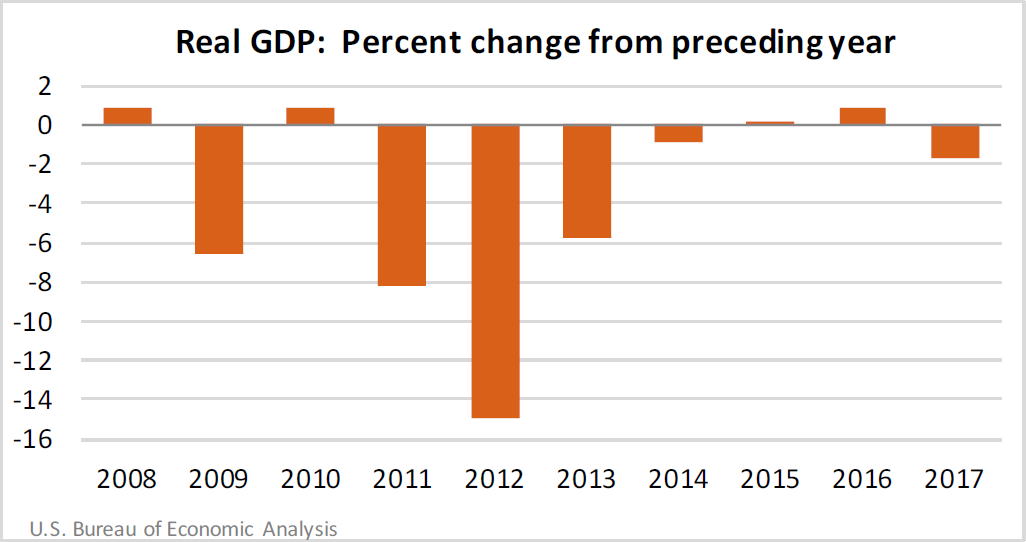News Release
U.S. Virgin Islands GDP Decreases in 2017
Tourism spending declines following Hurricanes Irma and Maria
Today, the Bureau of Economic Analysis (BEA) is releasing estimates of gross domestic product (GDP) for the U.S. Virgin Islands (USVI) for 2017, in addition to estimates of GDP by industry and compensation by industry for 2016.1 These estimates were developed under the Statistical Improvement Program funded by the Office of Insular Affairs (OIA) of the U.S. Department of the Interior.
Effects of Hurricanes Irma and Maria on Source Data
The U.S. Virgin Islands suffered extensive damage from two major hurricanes in September 2017. These hurricanes affected the availability of various source data used in the estimation of USVI GDP, including financial statements for the territorial government and its independent agencies.

Gross Domestic Product for 2017
The estimates of GDP for the USVI show that real GDP—GDP adjusted to remove price changes—decreased 1.7 percent in 2017 after increasing 0.9 percent in 2016 (see Table 1.3). For comparison, real GDP for the United States (excluding the territories) increased 2.2 percent in 2017 after increasing 1.6 percent in 2016.
The decline in the USVI economy reflected decreases in exports of services and consumer spending (see Table 1.4). These decreases were partly offset by an increase in investment spending.
Exports of services, which consists primarily of spending by tourists, decreased 16.0 percent, after increasing for 5 consecutive years. Tourism arrivals decreased 24.1 percent; arrivals fell significantly in the months following Hurricanes Irma and Maria.
Consumer spending also decreased, reflecting widespread declines in household purchases of goods and services, including motor vehicles, food, housing and electricity, and health care.
Partly offsetting these declines was growth in investment spending, by both the private sector and by government. Private sector inventory investment increased, reflecting increased storage capacity at an oil storage terminal on St. Croix. Construction spending by the territorial government increased, reflecting hurricane recovery work.
Federal government spending also increased significantly due to disaster response activities, including a U.S. Army Corps of Engineers' mission to install temporary roofs on homes, schools, and the St. Thomas airport.
Gross Domestic Product by Industry and Compensation by Industry for 2016
The estimates of GDP by industry for the USVI show that the private sector was the source of the growth in real GDP in 2016 (see Table 2.5). The growth in “other services” reflected the reopening of an oil storage terminal on St. Croix; a new operator took ownership of the facility previously owned by Hovensa and began receiving shipments of petroleum.
The compensation by industry estimates, which are measured in current dollars, show trends in compensation for major industries (see Table 2.6). Total compensation increased in 2016, reflecting growth in wages for “other services.”
The accompanying tables present estimates for GDP and its major components, GDP by industry, and compensation by industry. Also included in this release are estimates for the major components of gross domestic income.
Revisions to GDP
Estimates for 2014 to 2016 that were released on December 1, 2017 have been revised in order to incorporate improvements to source data, including:
- newly available data for territorial government spending from government financial statements and
- updates to Census Bureau data on exports and imports of goods.
The revised estimates show a similar pattern of inflation-adjusted growth as the previously published estimates (see Table 1.7).
Future directions
Moving forward, an agreement between OIA and BEA will extend and improve the estimates of GDP for the USVI. The information provided by the USVI government will continue to be critical to the successful production of these estimates.
BEA currently plans to release GDP estimates for 2018 beginning in the summer of 2019. GDP by industry and compensation by industry estimates for 2017 will also be released at the same time.
1 These estimates are based on limited source data and are subject to revision.